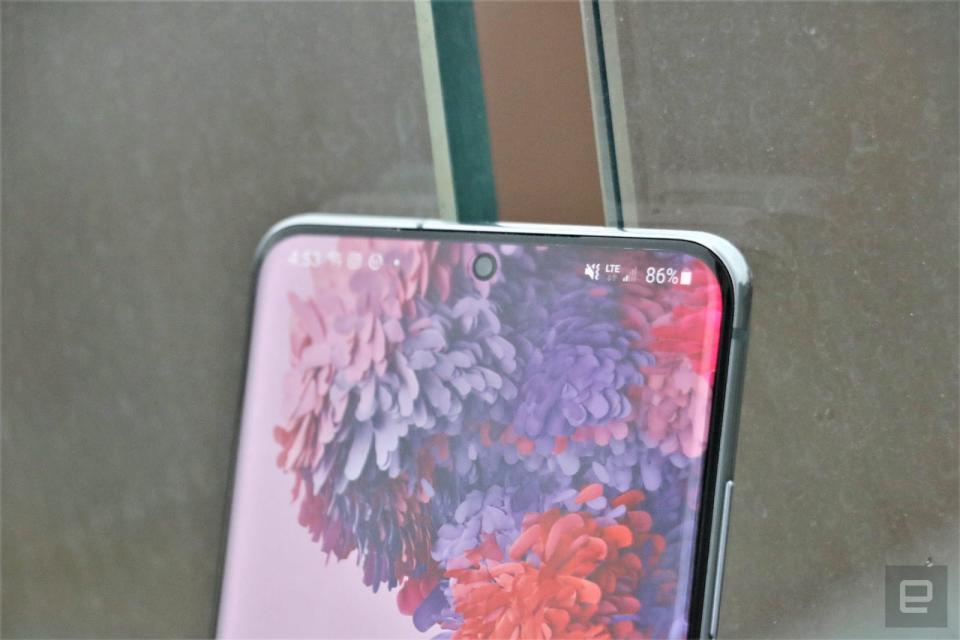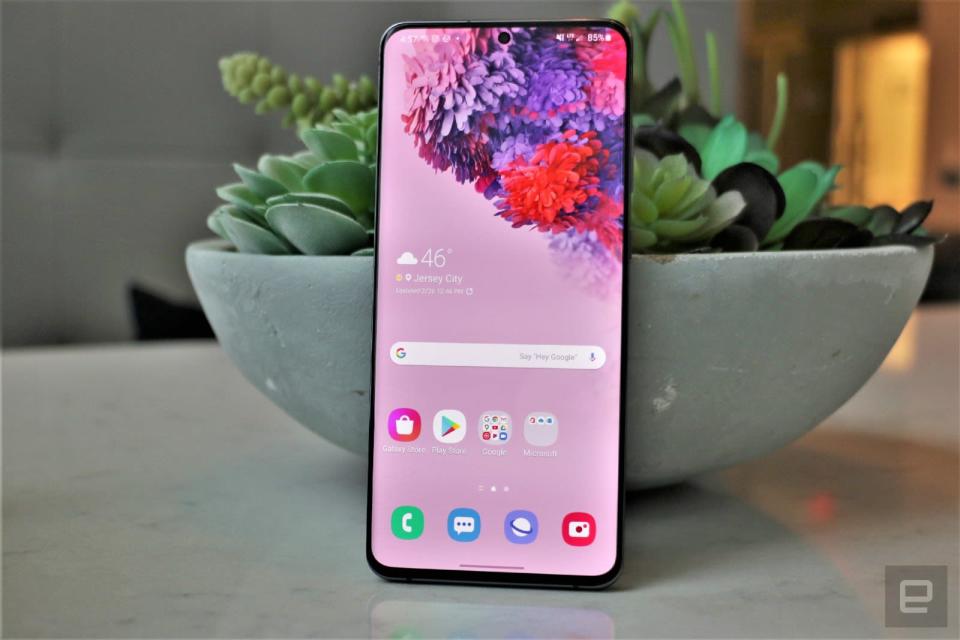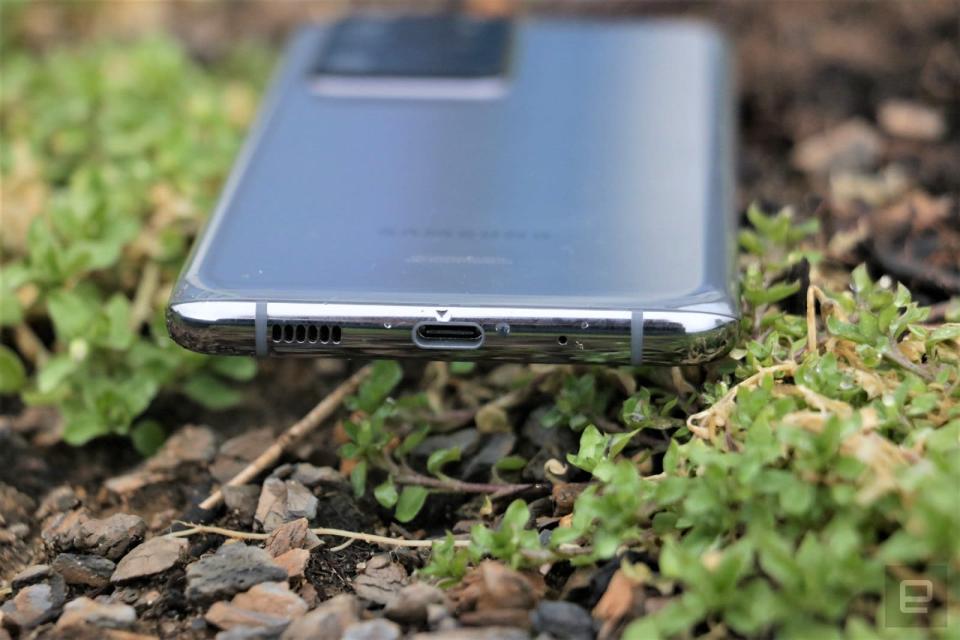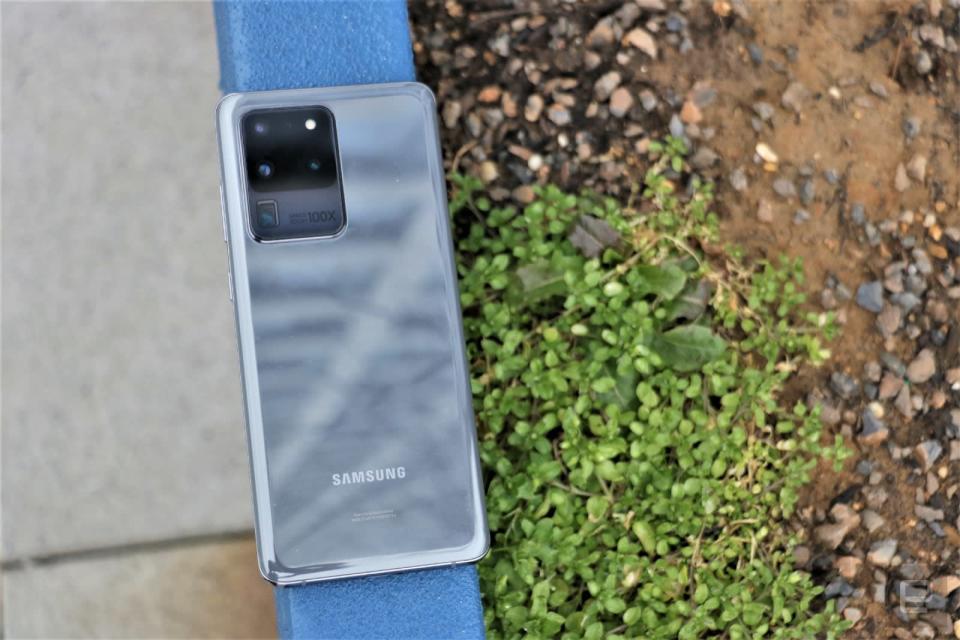Galaxy S20 Ultra review: Impressive but impractical
A phone for those with literally and figuratively deep pockets.
The first major phones of the year are here, and Samsung is being its usual ambitious self. The company unleashed a trio of new flagships in its S20 series, and for the first time, it introduced a souped-up Ultra variant alongside the regular S20 and S20+. The S20 Ultra is big and beefy, though with a starting price of $1,400, it's also very expensive. It offers a long list of impressive specs and intriguing features, like a triple camera system with a 108-megapixel sensor that can zoom up to 100x. But do these features make a good phone?
Size
One of the first things you should consider is the Ultra's size. As my colleague Chris Velazco so eloquently put it, the S20 Ultra is a chonky boi. Thicc with seven C's. With a 6.9-inch screen and a very dense build, the Ultra is the largest member of the S20 family ever. After just a day of testing it, my left thumb felt sore and my arm ached. I could never last more than 10 minutes of furious scrolling through my favorite subreddits.
To be fair, the S20 Ultra is only slightly larger than the iPhone 11 Pro Max, which is four grams heavier than the Samsung phone despite its smaller 6.5-inch screen. At 222 grams, the Ultra is noticeably heavier than the OnePlus 7T Pro (206 grams). Even the Note 10+ 5G, which has a slightly smaller 6.8-inch screen, weighs a lot less at 198 grams.
High-resolution, superzoom cameras
The biggest, most notable thing about the Ultra is its cameras. This is a tri-camera setup with a primary, 108-megapixel sensor and a 12-megapixel ultra-wide option that captures a 123-degree field of view. The most interesting of the lot, though, is the 48-megapixel telephoto lens folded into the chunky bump on top of this already-giant phone's behind.
Thanks to the bigger, sharper sensors, the S20 Ultra should take brighter, more colorful and clearer pictures than Samsung's previous flagships. But the company's image-processing algorithms are still pretty aggressive and soften details. Edges of buildings lack the definition you'd find on pictures taken with a Pixel 4 or an iPhone 11 Pro.
By default, the 108-megapixel camera snaps pictures at 12 megapixels using a process Samsung calls "nona-binning". Basically, it combines nine pixels into one on the sensor level to make them much bigger. Technically, that should result in brighter shots with less noise, but whether it's due to Samsung's algorithms or something else in the processing, the images just aren't very crisp no matter what resolution you're shooting at. Ultimately, the S20 Ultra's pictures are a minor improvement, at best, over the S10's.
The aggressive software also shows up in Live Focus and Night modes. The former adds an artificial blur to the background of your images to mimic bokeh, and Samsung's approach lags the competition. Google and even Apple are far better at recognizing outlines of people and applying bokeh that looks realistic and natural. And though I see an improvement in low-light photography and Night Mode on the S20 Ultra compared to the S10+, Google is still more effective at noise reduction and in darker conditions.
Besides the sharper sensors, the standout feature of the S20s is what Samsung calls "Space Zoom". On the S20 and S20 Plus, this lets you get up to 30 times closer to your subject. On the Ultra, you can go in up to 100x through a combination of optical zoom, digital zoom and a little AI trickery.
I've used the Ultra mostly to zoom in on buildings or faraway signs, and when you get beyond 10x, the image quality drops drastically. As with any other camera, every tiny movement is magnified when you're zoomed in that much. At 100x, it is nearly impossible to frame up a shot without a tripod and have it be still. At least Samsung includes a helpful visual guide in the top corners of the viewfinder for aiming. When you finally do line up a shot and take the picture, almost anything captured at beyond 10x is a muddy, noisy mess.
People have debated the ethics of such a feature and its potential for becoming a tool for snooping. And I have to admit, it's a bit creepy. Once, I shot up from the sidewalk into an apartment where a woman was having a conversation on the phone and looking out. Her face filled up the entire viewfinder at a mere 10x zoom and while I'm sure she didn't know I was that up close, it felt like she was staring right at me. I immediately felt uncomfortable and put the phone down.

Yes, Space Zoom is unsettling. Samsung is naive if it believes people are only going to use this feature to zoom in on tourist attractions from afar, like in the examples it gave at Unpacked. We'll have to rely on the decency of people who buy this phone to not use it for nefarious reasons, and depending on your worldview, that could be absolutely terrifying.
Moving on to a more fun addition to the camera experience -- the new Single Take mode. When you press the shutter button in this mode, the S20 captures a variety of shots and video from all the cameras. You'll have to hold the phone for a few seconds, and on-screen alerts will prompt you to move around to get different angles. When you're done, voila, the S20 spits out about 10 variations of your picture.
I like that Single Take serves up options I wouldn't have otherwise thought to take, like a monochrome version or a looping video set to a cheesy soundtrack. But it's not something I'd use all the time since it's best for moving subjects and I don't shoot those a lot. Parents of human and fur babies, for example, might find this more worthwhile.

I was concerned that the Ultra's 40-megapixel front camera would take selfies sharp enough to reveal every unflattering scar and stray eyebrow hair on my face. But by default, the system captures images at about 6.5-megapixel, and you have to manually select 40MP from the viewfinder. When I enabled high-res selfies, I wasn't as put off by the increased detail as I expected -- even after disabling beauty mode, which is turned on by default. I was surprised to see every strand of my hair so starkly, and honestly I don't think most people need or want selfies this sharp. But the pictures at either resolution will still serve you well -- they're bright and clear with accurate colors.
Fair warning though, since the image size is about three times that of a 6.5-megapixel version, these will suck up storage quickly and the phone struggled to keep up when I snapped a slew of them in rapid succession. Same goes with the 108-megapixel shots on the rear sensors.
Sharp, smooth video
Another thing I didn't find that useful was 8K video recording. Like Space Zoom, this is another feature that's really there for Samsung to say, "Hey, we did this technologically impressive thing!" Thanks to the S20's Snapdragon 865 processor, it can record the super high-res footage, so long as your device has enough storage and battery. It does put a bit of strain on the processor, though. I took some 8K clips of NYC streets, and the Ultra started to get a bit warm after about a minute.
The problem with 8K video isn't so much shooting it as it is trying to find somewhere to play it back. The S20 Ultra's screen is just Quad HD+, so watching it on the phone won't give you the full impact, and edges of buildings look distorted. Samsung's solution is to make it easy for you to cast your video to one of its 8K TVs, which are about as common in the wild as a panda bear. You can also upload it to YouTube, but again, you'll have to find a super high resolution screen to watch it on to really appreciate the quality.
I did like the improved Super Steady stabilization tool, though -- my footage turned out very smooth despite me tripping while walking on an uneven sidewalk. I have yet to notice the autofocus or frame dropping issues that other reviewers have reported during my video tests, although to be fair I haven't been able to play my footage back at the full 8K resolution. Again, these screens are hard to find.

Faster screens
Although watching 8K videos on the S20 Ultra is silly, it's still a lovely canvas. The cityscapes I shot looked crisp and colorful on the Ultra's 6.9-inch screen, even in sunlight. I also enjoyed watching a couple of 4K HDR videos and endless Instagram posts about my friends' exciting lives. Plus, the Ultra's almost all-screen front made the viewing experience more immersive and inviting.
One of the highlights on the S20 series is their 120Hz displays, which allows them to refresh much faster than other phones. So far, only the Razer Phone 2, the ASUS ROG Phone 2 and the Sharp AQUOS Zero 2 hit those rates. The Pixel 4 and OnePlus 7T Pro go up to 90hz. It's a growing trend, but certainly not a widespread feature yet.
To be clear, the S20 Ultra will only refresh that that rate at 1080p. If you want a higher 1440p resolution, you're stuck with 60Hz. The main benefit of a 120Hz screen is much smoother videos or games at that frame rate, though those are still relatively scant. But another bonus is that thumbing through pages on your phone will also look more fluid. Since so much of my activity online involves scrolling -- whether it's my Instagram or Twitter feeds or a random Reddit binge -- I thought this would be a huge improvement. But as much as I appreciated the smoother display, I didn't miss it when I went back to my Pixel 3. The Pixel 4, with its 90Hz screen, was more than fast enough for me.

5G in the real world today
Speaking of fast, the S20 series supports both sub-6 and millimeter wave 5G, and the latter promises serious speed improvements. Of course, I was also slightly concerned about the difficulty in maintaining a connection because they're notoriously easy to disrupt. If your hand completely covers the antenna, for example, you might lose your signal.
I was hoping that technologies like beamforming and beam-tracking would make mmWave signals more reliable, but it was embarrassingly easy to interrupt them in New York. Our review unit was running on Verizon's network, but the Ultra will support 5G on all carriers. Since Verizon only offers mmWave 5G right now with no sub-6, and those waves don't propagate as far, coverage is still quite limited. I had to hunt down nodes through an online map to go chill out within line of sight of one of them to test these supposed super fast downloads.
On a Verizon phone, the 5GUWB icon that indicates a mmWave connection only shows up when an active data download is happening on the network. So, even though I saw the icon switch between 5GUWB and LTE as I walked up and down a block in Brooklyn that had a node on the corner, it wasn't a good indicator of coverage.
When I did manage to latch on to a signal, though, the rewards were huge. I hit up to 800 Mbps download speeds, according to Speedtest, when connected to a 5G node in Manhattan. A 4K video that took me 13 minutes to download over 4G LTE came through in just 13 seconds on mmWave. Uploads, on the other hand, were only about 50 Mbps, but that's because Verizon is still using LTE for all uploads. That means posting your Instagram Stories or YouTube videos on the carrier won't be any quicker.
Battery life and performance
One of the biggest concerns about technologies like mmWave 5G or a screen with a high refresh rate is their impact on battery life. To allay our concerns, Samsung stuffed a whopping 5,000mAh cell into the Ultra. I set my screen to 120Hz and used the S20 Ultra for a ton of photo taking and Instagramming, along with the usual slew of messaging, and the battery lasted about a day and a half. On our battery test, the S20 Ultra lasted 11 and a half hours, which is surprisingly shorter than the Pixel 4 XL. It does line up with the S10+ and outlast the iPhone 11 Pro Max in general use, though.
I mostly used the S20 Ultra for messaging, Instagram and Twitter as well as taking a ton of photos and videos. The Snapdragon 865 chipset held up well in general, and the phone only stalled once when I was trying to switch camera modes while a video was still saving. To push the S20 Ultra harder, I played a round of Call Of Duty Mobile while recording the screen, and then quickly tried to edit the video. Unsurprisingly, the phone managed all that without a hiccup.
Since it is a Galaxy S flagship after all, the Ultra also offers features from older stablemates like an in-display fingerprint sensor, reverse wireless charging and Bixby Routines -- you know, in case you found that useful. You'll also get the standard set of pre-loaded apps from Samsung, Google and Microsoft, but for some reason Netflix and Facebook also come installed. That's fine, most people use these apps. But for those who don't, or if you're against Facebook on principle (like I am), bad news: You can't uninstall either. Your only option is to disable them, which removes them from your app drawer and silences notifications. Still, that's a relatively minor gripe.

Wrap-up
The S20 Ultra is a bombastic device with a feature list boasting big numbers like 108 megapixels, 100x zoom, 8K video, 120Hz screen and 5G support. These are the best specs you can get for cameras, displays and connectivity today. And for people who care only about getting the best of the best (aside from the camera anyway), the S20 Ultra is an excellent device.
But there's an even bigger number that we cannot ignore: $1,400. The S20 Ultra is more expensive than the Galaxy Z Flip, which uses new and costly folding display technology. For this price, Samsung needs to deliver something nearly perfect; the Ultra is not. Its camera issues and heft keep it from being the best in the market. For those looking to upgrade from an older device, bear in mind that Samsung cut the prices for the S10 series, which are still a big jump up from older flagships.
If you don't need the most advanced phone available, the S20 Ultra is certainly overkill. Few of us need anything this extreme -- it's hard to imagine situations where the S20 or S20+ wouldn't be enough. If you simply must have the highest specs, the Ultra will satisfy -- just remember that you don't need to spend this much for a great smartphone.


